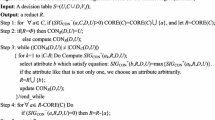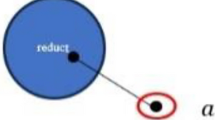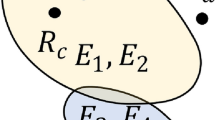Abstract
Attribute reduction in formal concept analysis is a highly concerned dimensionality reduction method, which purifies formal context by removing unimportant attributes. Current trends of dealing with attribute reduction problem for large-scale datasets is mainly based on object updating, thus, ignore the fact that attributes may also be modified with evolving time. With that in mind, this study considers the attribute reduction of the data with attribute dynamic environments. Specifically, we first analyze the incremental mechanism of granular reduct in a formal context, as well as develop the corresponding incremental algorithms. Then, in a consistent formal decision context, we address the consistency-based incremental attribute reduction problem on the premise that the decision attribute set remains unchanged. In addition, to obtain a smaller reduction, attribute significance is defined to measure the identification ability of attributes to inconsistent objects. Different from the existing methods, the algorithms proposed in this paper can realize dynamic calculation of granular reduct and the numerical experiments conducted show that the algorithm proposed in this paper is more efficient than other algorithms in the face of large-scale datasets. In the meantime, the generated granular reduct can improve the accuracy of classifiers in the classification task.






Similar content being viewed by others
Explore related subjects
Discover the latest articles, news and stories from top researchers in related subjects.References
Wille R (1982) Restructuring lattice theory: an approach based on hierarchies of concepts. In: Ordered sets, pp 445–470. https://doi.org/10.1007/978-94-009-7798-3_15
Pawlak Z (1982) Rough sets. Int J Comput Inform Sci 11(5):341–356. https://doi.org/10.1007/BF01001956
Zadeh LA (1965) Fuzzy sets. Inform Control 8(3):338–353. https://doi.org/10.1016/S0019-9958(65)90241-X
Li JH, Mei CL, Lv YJ (2013) Incomplete decision contexts: approximate concept construction, rule acquisition and knowledge reduction. Int J Approx Reason 54(1):149–165. https://doi.org/10.1016/j.ijar.2012.07.005
Li JH, Mei CL, Kumar CA et al (2013) On rule acquisition in decision formal contexts. Int J Mach Learn Cybern 4(6):721–731. https://doi.org/10.1007/s13042-013-0150-z
Li JH, Kumar CA, Mei CL et al (2017) Comparison of reduction in formal decision contexts. Int J Approx Reason 80(3):100–122. https://doi.org/10.1016/j.ijar.2016.08.007
Carpineto C, Romano G (1996) A lattice conceptual clustering system and its application to browsing retrieval. Mach Learn 24(2):95–122. https://doi.org/10.1007/BF00058654
Godin R, Missaoui R, Alaoui H (1995) Incremental concept formation algorithm based on Galois (concept) lattices. Comput Intell 11(2):246–67. https://doi.org/10.1111/j.1467-8640.1995.tb00031.x
Kumar CA (2012) Fuzzy clustering-based formal concept analysis for association rules mining. Appl Artif Intell 26(3):274–301. https://doi.org/10.1080/08839514.2012.648457
Li KW, Shao MW, Wu WZ (2017) A data reduction method in formal fuzzy contexts. Int J Mach Learn Cybern 8(4):1145–1155. https://doi.org/10.1007/s13042-015-0485-8
Ma JM, Hu LL, Qian YH (2019) Object-oriented interval-set concept lattices. Int J Approx Reason 110:64–81. https://doi.org/10.1016/j.ijar.2019.03.012
Yao YY (2016) Three-way decisions and cognitive computing. Cogn Comput 8(4):543–554. https://doi.org/10.1007/s12559-016-9397-5
Yao YY (2018) Three-way decision and granular computing. Int J Approx Reason 103:107–123. https://doi.org/10.1016/j.ijar.2018.09.005
Wang XZ, Dong LC, Yan JH (2012) Maximum ambiguity-based sample selection in fuzzy decision tree induction. IEEE Trans Knowl Data Eng 24(8):1491–1505. https://doi.org/10.1109/TKDE.2011.67
Wang XZ, Xing HJ, Li Y et al (2015) A study on relationship between generalization abilities and fuzziness of base classifiers in ensemble learning. IEEE Trans Fuzzy Syst 23(5):1638–1654. https://doi.org/10.1109/TFUZZ.2014.2371479
Ni P, Zhao SY, Wang XZ et al (2020) Incremental feature selection based on fuzzy rough sets. Inform Sci 536:185–204. https://doi.org/10.1016/j.ins.2020.04.038
Wang CZ, Hu QH, Wang XZ et al (2018) Feature selection based on neighborhood discrimination index. IEEE Trans Neural Netw Learn Syst 29(7):2986–2999. https://doi.org/10.1016/10.1109/TNNLS.2017.2710422
Zhang WX, Wei L, Qi JJ (2005) Attribute reduction theory and approach to concept lattices. Sci China Ser F 48(6):713–726. https://doi.org/10.1360/122004-104
Zhang WX, Wei L, Qi JJ (2005) Attribute reduction in concept lattice based on discernibility matrix. In: International workshop on rough sets, fuzzy sets, data mining, and granular-soft computing, Springer, Berlin, pp 157–165
Yang YY, Chen DG, Dong Z (2014) Novel algorithms of attribute reduction with variable precision rough set model. Neurocomputing 139:336–344. https://doi.org/10.1016/j.neucom.2014.02.023
Chen DG, Zhang L, Dong Z (2016) An incremental algorithm for attribute reduction with variable precision rough sets. Appl Soft Comput 45:129–149. https://doi.org/10.1016/j.asoc.2016.04.003
Chen DG, Zhao SY, Zhang L et al (2012) Sample pair selection for attribute reduction with rough set. IEEE Trans Knowl Data Eng 24(11):2080–2093. https://doi.org/10.1109/TKDE.2011.89
Chen DG, Hu QH, Yang YP (2011) Parameterized attribute reduction with gaussian kernel based fuzzy rough sets. Inf Sci 181(23):5169–6179. https://doi.org/10.1016/j.ins.2011.07.025
Leung Y, Fischer MM, Wu WZ et al (2008) A rough set approach for the discovery of classification rules in interval-valued information systems. Int J Approx Reason 47(2):233–246. https://doi.org/10.1016/j.ijar.2007.05.001
Mi JS, Wu WZ, Zhang WX (2004) Approaches to knowledge reductions based on variable precision rough sets model. Inf Sci 159(3–4):255–272. https://doi.org/10.1016/j.ins.2003.07.004
Mi JS, Leung Y, Wu WZ (2010) Approaches to attribute reduction in concept lattices induced by axialities. Knowl-Based Syst 23(6):504–511. https://doi.org/10.1016/j.knosys.2010.03.007
Wu WZ (2008) Attribute reduction based on evidence theory in incomplete decision systems. Inf Sci 178(5):1355–1371. https://doi.org/10.1016/j.ins.2007.10.006
Hu QH, Yu DR, Liu JF et al (2008) Neighborhood rough set based heterogeneous feature subset selection. Inf Sci 178(18):3577–3594. https://doi.org/10.1016/j.ins.2008.05.024
Zhang CC, Dai JH, Chen JL (2020) Knowledge granularity based incremental attribute reduction for incomplete decision systems. Int J Mach Learn Cybern 11(6):1141–1157. https://doi.org/10.1007/s13042-020-01089-4
Chen JK, Mi JS, Xie B et al (2021) Attribute reduction in formal decision contexts and its application to finite topological spaces. Int J Mach Learn Cybern 12(3):39–52. https://doi.org/10.1007/s13042-020-01147-x
Qi JJ (2009) Attribute reduction in formal contexts based on a new discernibility matrix. J Appl Math Comput 30(1–2):305–314. https://doi.org/10.1007/s12190-008-0174-9
Liu M, Shao MW, Zhang WX et al (2007) Reduction method for concept lattices based on rough set theory and its application. Comput Math Appl 53(9):1390–1410
Wei L, Qi JJ, Zhang WX (2008) Attribute reduction theory of concept lattice based on decision formal contexts. Sci China Ser F Inf Sci 51(7):910–923. https://doi.org/10.1007/s11432-008-0067-4
Wang H, Zhang WX (2008) Approaches to knowledge reduction in generalized consistent decision formal context. Math Comput Model 48(11–12):1677–1684. https://doi.org/10.1016/j.mcm.2008.06.007
Li JH, Mei CL, Lv YJ (2011) A heuristic knowledge-reduction method for decision formal contexts. Comput Math Appl 61(4):1096–1106. https://doi.org/10.1016/j.camwa.2010.12.060
Kumar CA, Dias SM, Newton JV (2015) Knowledge reduction in formal contexts using non-negative matrix factorization. Math Comput Simul 109(C):46–63. https://doi.org/10.1016/j.matcom.2014.08.004
Ganter B, Wille R (1999) Formal concept analysis. Mathematical foundations. Springer, Berlin
Wu WZ, Leung Y, Mi JS (2009) Granular computing and knowledge reduction in formal contexts. IEEE Trans Knowl Data Eng 21(10):1461–1474. https://doi.org/10.1109/TKDE.2008.223
Shao MW, Lung Y (2014) Relation between granular reduct and dominance reduct in formal contexts. Knowl-Based Syst 65:1–11. https://doi.org/10.1016/j.knosys.2014.03.006
Huang CC, Li JH, Disa SM (2016) Attribute significance, consistency measure and attribute reduction in formal concept analysis. Neural Netw Eorld 26(6):607–623. https://doi.org/10.14311/NNW.2016.26.035
Chen JK, Mi JS, Lin YJ (2018) A graph approach for knowledge reduction in formal contexts. Knowl-Based Syst 148:177–188. https://doi.org/10.1016/j.knosys.2018.02.039
Lin YD, Li JJ, Wang HK (2020) Granular matrix method of attribute reduction in formal contexts. Soft Comput 24(21):16303–16314. https://doi.org/10.1007/s00500-020-04941-5
Li JH, Mei CL, Xu WH et al (2015) Concept learning via granular computing: a cognitive viewpoint. Inf Sci 298:447–467. https://doi.org/10.1016/j.ins.2014.12.010
Niu JJ, Huang CC, Li JH et al (2018) Parallel computing techniques for concept-cognitive learning based on granular computing. Int J Mach Learn Cybern 9(11):1785–1805. https://doi.org/10.1007/s13042-018-0783-z
Zhao YX, Li JH, Liu WQ et al (2017) Cognitive concept learning from incomplete information. Int J Mach Learn Cybern 8(1):159–170. https://doi.org/10.1007/s13042-016-0553-8
Kent RE (1994) Rough concept analysis. In: Ziarko WP (ed) Rough sets, fuzzy sets and knowledge discovery. Springer-Verlag, London, pp 248–255
Yao YY (2004) Concept lattices in rough set theory. In: Proceedings of 2004 annual meeting of the North American fuzzy information processing society. IEEE Computer Society, Washington, DC, pp 796-801. https://doi.org/10.1109/NAFIPS.2004.1337404
Yao YY (2004) A comparative study of formal concept analysis and rough set theory in data analysis. In: Proceedings of 4th international conference on rough sets and current trends in computing, Uppsala, Sweden, pp 59-68. https://doi.org/10.1007/978-3-540-25929-9_6
Wang LD, Liu XD (2008) Concept analysis via rough set and AFS algebra. Inf Sci 178(21):4125–4137. https://doi.org/10.1016/j.ins.2008.07.004
Guo LK, Huang FP, Li QG et al (2011) Power contexts and their concept lattices. Discrete Math 311(18–19):2049–2063. https://doi.org/10.1016/j.disc.2011.04.033
Qi JJ, Qian T, Wei L (2016) The connections between three-way and classical concept lattices. Knowl-Based Syst 91:143–151. https://doi.org/10.1016/j.knosys.2015.08.006
Acknowledgements
This work was supported by the National Key R&D Program of China (2020YFB1707802) and the National Natural Science Foundation of China (No. 12071131).
Author information
Authors and Affiliations
Corresponding author
Additional information
Publisher's Note
Springer Nature remains neutral with regard to jurisdictional claims in published maps and institutional affiliations.
Rights and permissions
About this article
Cite this article
Niu, J., Chen, D. Incremental calculation approaches for granular reduct in formal context with attribute updating. Int. J. Mach. Learn. & Cyber. 13, 2763–2784 (2022). https://doi.org/10.1007/s13042-022-01561-3
Received:
Accepted:
Published:
Issue Date:
DOI: https://doi.org/10.1007/s13042-022-01561-3




